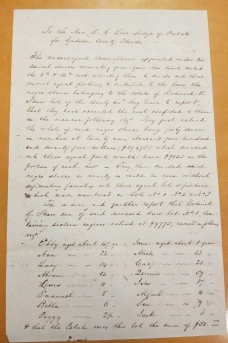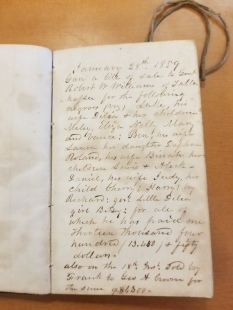Special Collections and Archives spent this summer contributing to two projects centered on the lives of local enslaved people. Currently, we are supporting the Tallahassee History and Human Rights Project. The first phase of this collaborative effort between the Grove Museum, Goodwood Museum & Gardens, the Tallahassee Museum, and the community seeks to better interpret the lives and experiences of the enslaved people that lived on and built the plantations at those sites.

To support them, Special Collections & Archives identified manuscript collections, rare books, oral histories, and historic newspapers held at FSU that provide insight on African and African American lives from Territorial Florida to the Great Depression in Tallahassee and surrounding counties. We primarily found plantation records, personal papers, and business records documenting the era of enslavement and sharecropping in the Tallahassee locale. Please join these three museums for a series of tours on Saturday, September 14th that commemorate the lives and experiences of local enslaved people.
Alongside the research done for the Tallahassee History and Human Rights Project, Special Collections and Archives digitized and submitted objects to a collaborative online exhibit curated by the Association of Southeast Research Libraries (ASERL). The exhibit recognizes and commemorates the 400 years since the arrival of enslaved Africans in the United States.

The exhibit covers five periods: Colonial, American Revolution and Constitution, Antebellum, Civil War, and Twentieth Century. The digital exhibit is slated to debut on the Omeka platform in November. Our contributions, including the Whitfield Notebook to the right, have been digitized and added to our digital library, DigiNole.
Supporting these initiatives led Special Collections and Archives to question how to make our own holdings more visible and accessible. We started with the objects submitted to the ASERL Exhibit and added them to our digital library. The documents below are examples of what we identified that will be digitized in the near future. Alongside digitization, we have begun to incorporate these materials in class visits and aim to include them in research guides. As always, we encourage everyone to visit our reading room to view and work with our collections.
New additions to the digital library documenting enslavement and sharecropping include manuscript and printed sharecropping contracts, the Whitfield Notebook, and the R.F. Van Brunt General Store 1911 Day Book.
Special Collections & Archives welcomes visitors to our reading room on the first floor of Strozier Library Monday-Thursday from 10:00-6:00 and Friday from 10:00-5:30.

